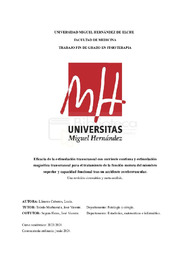Título :
Eficacia de la estimulación transcraneal con corriente continua y estimulación magnética transcraneal para el tratamiento de la función motora del miembro superior y capacidad funcional tras un accidente cerebrovascular.
Una revisión sistemática y meta-análisis. |
Autor :
Llinares Cabezos, Lucía |
Tutor:
Toledo Marhuenda, José Vicente
Segura Heras, José Vicente |
Editor :
Universidad Miguel Hernández |
Departamento:
Departamentos de la UMH::Patología y Cirugía
Departamentos de la UMH::Estadística, Matemáticas e Informática |
Fecha de publicación:
2024-06-04 |
URI :
https://hdl.handle.net/11000/33612 |
Resumen :
Introducción: El accidente cerebrovascular (ACV) es una de las principales causas de mortalidad y
discapacidad en el mundo, siendo la fisioterapia la opción de tratamiento más habitual para el déficit
motor residual. Sin embargo, falta por conocer si el uso de la estimulación cerebral no invasiva podría
ser una nueva línea de tratamiento en la práctica clínica.
Objetivos: Evaluar la eficacia de la estimulación transcraneal con corriente continua (tDCS) y la
estimulación magnética transcraneal (rTMS) para el tratamiento de la función motora del miembro
superior y capacidad funcional tras un ACV.
Métodos: Se llevó a cabo una búsqueda electrónica de literatura, siguiendo la pregunta PICO-S, en
las bases de datos EMBASE y PubMed de ensayos clínicos aleatorizados. Dos revisores examinaron
la elegibilidad de los artículos. Se evaluó el riesgo de sesgo con la herramienta Cochrane y la calidad
metodológica mediante la escala PEDro.
Resultados: de los 11 estudios seleccionados, cuatro realizaron la intervención utilizando rTMS y los
siete restantes mediante tDCS. Combinaron la estimulación con otras técnicas como fisioterapia,
terapia asistida por robot (RAT) o restricción del lado sano (CIMT). En los grupos controles se usó la
estimulación placebo junto con las terapias descritas.
Conclusión: tras observar los resultados obtenidos con este meta-análisis, no se puede afirmar que el
uso de tDCS y de rTMS resulten eficaces para tratar la función motora y capacidad funcional tras un
ACV.
Introduction: Stroke (CVA) is one of the leading causes of mortality and disability worldwide, with
physiotherapy being the most common treatment option for residual motor deficit. However, it
remains to be seen whether the use of non-invasive brain stimulation could be a new line of treatment
in clinical practice.
Objectives: To evaluate the efficacy of transcranial direct current stimulation (tDCS) and transcranial
magnetic stimulation (rTMS) for the treatment of upper limb motor function and functional capacity
after stroke.
Methods: An electronic literature search, following the PICO-S query, was conducted in the
EMBASE and PubMed databases for randomised clinical trials. Two reviewers screened articles for
eligibility. Risk of bias was assessed using the Cochrane tool and methodological quality using the
PEDro scale.
Results: Of the 11 selected studies, four performed the intervention using rTMS and the remaining
seven using tDCS. They combined stimulation with other techniques such as physiotherapy,
robot-assisted therapy (RAT) or healthy side restraint (CIMT). In the control groups, placebo
stimulation was used together with the described therapies.
Conclusion: Based on the results of this meta-analysis, it cannot be concluded that tDCS and rTMS
are effective in treating motor function and functional ability after stroke.
|
Palabras clave/Materias:
Stroke
Transcranial Direct Current Stimulation
Transcranial Magnetic Stimulation |
Área de conocimiento :
CDU: Ciencias aplicadas |
Tipo de documento :
info:eu-repo/semantics/bachelorThesis |
Derechos de acceso:
info:eu-repo/semantics/openAccess
Attribution-NonCommercial-NoDerivatives 4.0 Internacional |
Aparece en las colecciones:
TFG - Fisioterapia
|
 La licencia se describe como: Atribución-NonComercial-NoDerivada 4.0 Internacional.
La licencia se describe como: Atribución-NonComercial-NoDerivada 4.0 Internacional.
.png)
